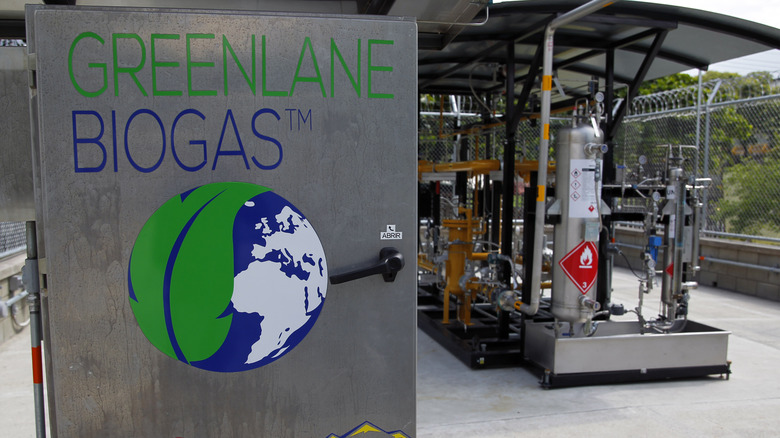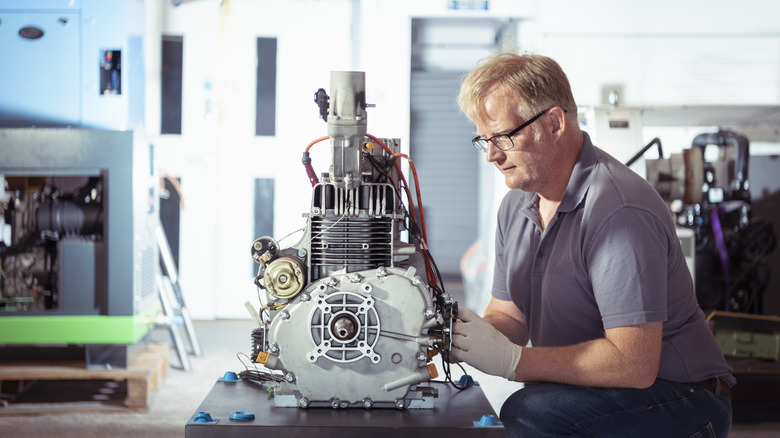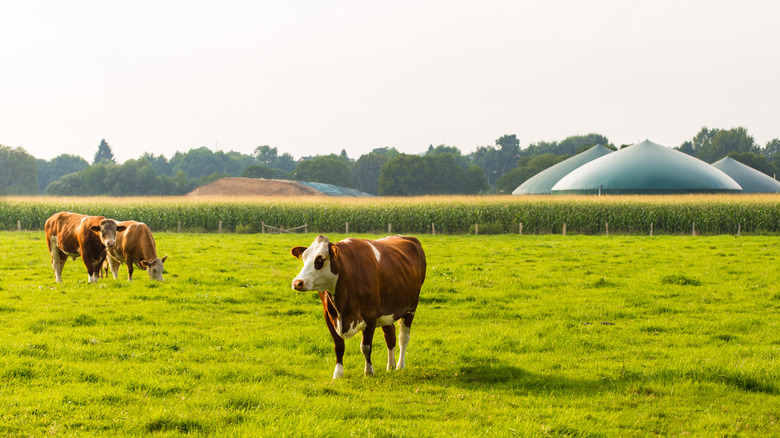Biomethane Engines Explained: What Are They And How Do They Work?
Fossil fuels aren't going to last forever. While many experts argue about the exact year when we can expect the final nail in the coffin, the reality is that factors like increased consumption and the discovery of new reserves can make it unpredictable. Regardless, it's still widely agreed upon that it is going to run out at some point, so it's a race against time to transition to renewable energy sources that can take its place. Some people are making a bet that the answer can actually be in our waste.
In 2022, more than a quarter of all American energy consumption was attributed to transportation, according to the U.S. Energy Information Administration (EIA). Given this, it's unsurprising that finding alternative fuel sources and designing engines that can use them effectively could potentially be what we need to move the needle. And one possible solution that experts have raised to solve this is transitioning towards biofuels, like biomethane.
In 2023, Fortune Business Insights shared that not only was the alternative fuel industry already worth more than $460 billion, but it is also expected to be valued ten times more than that in just nine years. Plus, there's only a little under a decade left before the European Union officially bans the sale of new fossil fuel-powered cars in 2035. Knowing this, there are growing incentives for investors to support the development of alternative fuels. So, how does biomethane play into this, and what makes it different from other fuel alternatives?
What is biomethane?
Before we go into what biomethane is, we first have to understand its most important component: Biogas. In simple terms, biogasis one of the products that naturally occur after organic materials undergo anaerobic digestion. Under ordinary circumstances, this process happens without human interference in places like landfills, farms, and waste treatment facilities.
In the past, biogas was used to power everything from street lights to Apple's Data Centers. However, to be able to work as a proper alternative in natural gas engines, biogas needed to be processed further to improve its quality and efficiency. Part of this is so that it decreases the risk of damaging engines that were designed for use with natural gas, especially because some biogas can contain damaging chemicals like siloxanes. Thankfully, researchers have been able to optimize this process to create a fuel alternative, Renewable Natural Gas (RNG). According to the Environmental Protection Agency (EPA), RNG can be added directly into the existing fossil fuel natural gas distribution infrastructure and used with existing natural gas engines (with some additional refinement versus when used for other applications).
At present, most of the world's biomethane is a product of biogas that has been purified or "upgraded." To bring biogas to the next level, EPA states that contaminants like nitrogen, carbon dioxide, and other volatile organic compounds are removed in the process. However, IEA also shares that there are alternative ways that biomethane can also be made, like exposing certain biomass to specific conditions, like extreme pressure and heat.
How do biomethane engines work
Since it functions essentially like natural gas, biomethane can utilize similar infrastructure for its distribution practices and can be used in internal combustion engines (ICE) that were designed for it. In fact, many European countries, such as Sweden, France, and Germany, have already been adding biomethane to their natural gas grids for years. In 2010, Volkswagen launched tests for the Bio-Bug in the United Kingdom, the first biogas-powered car (which could also run on gasoline) that it claims didn't sacrifice performance. In partnership with sustainable energy firm GENeco, the six-month trial utilized human waste gathered from Bristol residential homes to produce the alternative fuel. But recently, biomethane has been taking the spotlight.
In December 2023, a biomethane-compatible version of its heavy-duty OC13 truck engines was released by Scania, which it claimed could increase fuel savings by up to 5% for commercial fleets. A year later, leading Japanese automotive manufacturers Toyota, Suzuki, and Nissan also shared their plans to develop vehicles that reflect a growing need for reduced emissions, which include investing in biomethane engines. In fact, one highly-awaited biomethane-powered vehicle set to take the streets soon is the Suzuki WagonR.
In line with this, several Japanese companies have also been making notable leaps in developing and experimenting with supporting technology throughout the years, like facilities that convert agricultural waste into biogas and conducting trials for liquified biomethane-powered vessels.
The problem with biomethane engine systems
These days, even electric vehicles have hidden carbon footprints throughout its supply chain and end-of-life experience. So, what's the problem with biomethane engines exactly? To start with, a decade-old Elsevier study (PDF) on the risks associated with large-scale biogas production revealed that damages to processing facilities, in particular the fermenters and gas buffers, could lead to both poisoning and combustion.
Unfortunately, some scientists are still concerned that the biomethane production facilities don't take into consideration public health and safety implications to surrounding communities that can arise from the processing, even in recent times. In 2022, another study from the Environmental Justice journal claimed that the anaerobic digestion process necessary for the creation of methane also emits other toxic emissions, like NOx, which can cause a host of health concerns that range from respiratory issues to mood disorders.
On the business side, the Journal of Cleaner Production published a study highlighting several existing logistical challenges related to supplying biomethane for large-scale fleet operations in 2023. Plus, an MDPI case study also revealed that biomethane could be less efficient than its natural gas counterpart, mainly due to its reduced methane concentration, in the same year. However, these may just be problems that new technology can solve, especially now that biomethane-specific engines are being actively developed by car manufacturers. That said, it's important to note that despite all the challenges listed above, there's still a lot to gain from exploring the potential of biomethane engines.
Why biomethane engines can still be the future
On moving away from fossil fuels, our team recently spoke with Dr. Laine Mears, the Automotive Manufacturing Chair of Clemson University's Department of Automotive Engineering. In the interview, he said, "I would not say there were engineering hurdles, more than I would say this is a problem with market inertia and the economic drivers that keep gas (and diesel) vehicles on the road." In other words, there are a lot of options for sustainable energy alternatives, but people need to be incentivized to switch.
In some ways, biomethane engines can do just that, especially because it has a lot of features that could make it convenient to use and produce. Unlike other forms of renewable energy that have a lot of limitations in terms of location, there's an abundance of organic waste everywhere. And, of course, the increased use of biomethane engines and the demand for fuel can help close the loop between a lot of waste that comes from notable industries, like manufacturing and agriculture.
Not to mention, there has been a lot of promise in terms of it being a significantly cheaper alternative to natural gas. For example, the cost of producing biomethane in Europe was about a third of the cost of natural gas in 2022, according to the European Biogas Association. Lastly, because it can be used with existing natural gas-powered vehicles, it can be less painful for ordinary consumers to make the change.




